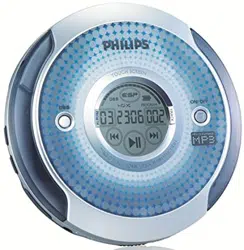Documents: Go to download!
User Manual
- User Manual - (English, French, Spanish)
- Specification Sheet - (English)
- CONTROLS
- REMOTE CONTROL AY5502 (for EXP258X only)
- POWER SUPPLY
- GENERAL INFORMATION
- HEADPHONE
- ABOUT MP3 /WMA
- QUICK START
- PLAYING A CD
- VOLUME AND SOUND
- SELECTING A TRACK AND SEARCHING
- SELECTING DIFFERENT PLAYING POSSIBILITIES − MODE
- PROGRAMMING TRACKS
- RESUME / HOLD
- ESP, POWER SAVE MODE
- TROUBLESHOOTING
- IMPORTANT SAFETY INSTRUCTIONS
Table of contents
Portable MP3-CD Player User manual
CONTROLS

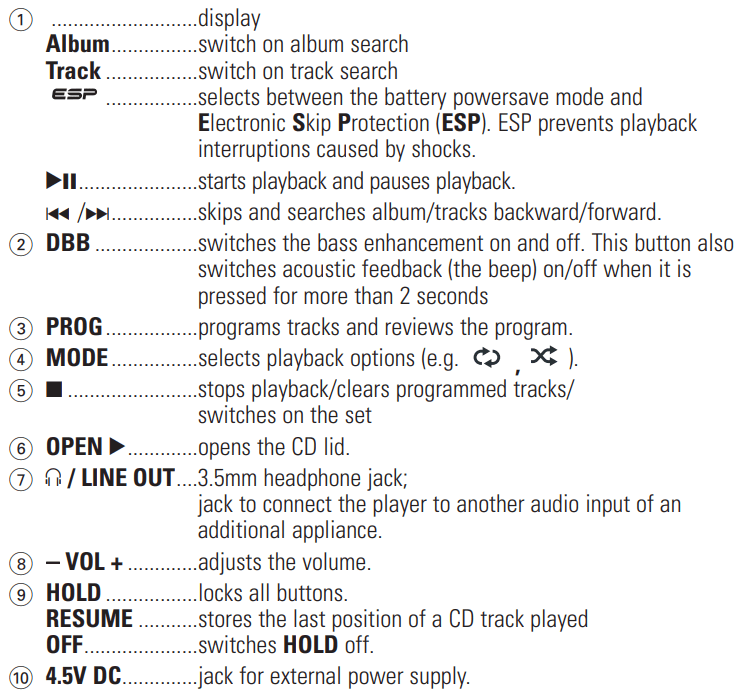
REMOTE CONTROL AY5502 (for EXP258X only)
Remote control AY5502 ( see figure 2)
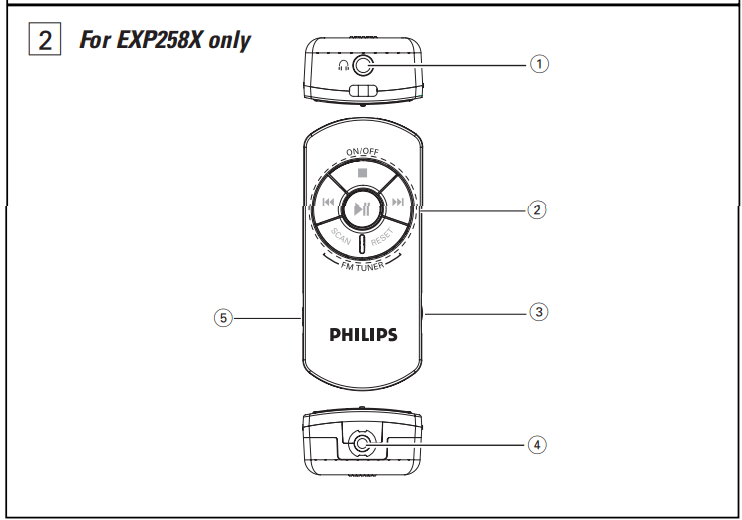
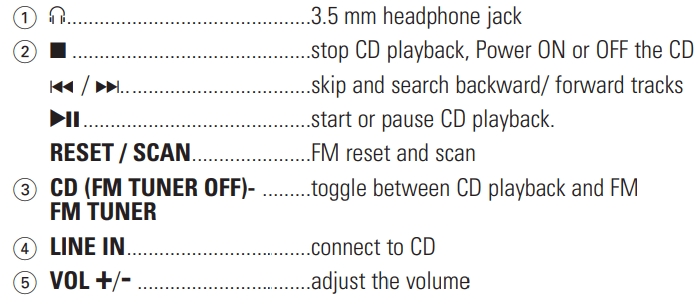
The type plate is located on the bottom of the set.
Using the remote control
The remote control allows you to command all the functions on the player.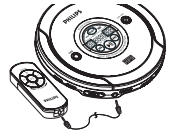
- Firmly connect the remote control to LINE OUT
 on the set.
on the set. - Firmly connect the headphones to the jack
 on the remote control.
on the remote control. - When the slide switch is at CD position, you can only use CD control buttons
- When the slide switch is at FM position, you can only use FM control buttons.
Helpful Hints:
– The indication FM TUNER is displayed. You cannot power on the CD.
– Check the slider on the remote. Make sure it is slided to the CD position
– Or unplug the remote connection cable from the CD player
Listen to CD :
- Slide the switch to CD position.
- Use
 to control the CD playback
to control the CD playback - On the remote control, press
 to start playback.
to start playback. - Adjust the volume and sound on your remote control.
- To stop playback, press
 .
. - To switch off the CD player, press
 again.
again.
Listen to FM station :
- Slide the switch to FM position, press SCAN once or more to find your desired station.
- Repeat step 1 to find another station.
- If no stations are found, press RESET and repeat steps 1-2.
- To switch off the FM, slide the switch to CD (FM OFF) position.
CAUTION: Use of controls or adjustments or performance of procedures other than herein may result in unsafe operation.
POWER SUPPLY
Batteries (not included)
Inserting AA (LR6, UM3) batteries
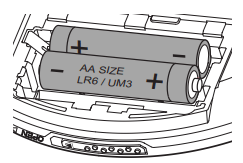
- Open the battery compartment.
- Insert 2 x AA batteries as shown into the battery compartment.
- Close the battery compartment.
Helpful Hints:
– Old and new or different types of batteries should not be combined.
– Remove batteries if they are empty or if the player is not going to be used for a long time.
Battery indication
The approximate power level of your batteries is shown in the display.
 : Battery full
: Battery full
 : Battery two-thirds full
: Battery two-thirds full
 : Battery one-third full
: Battery one-third full
 : Battery dead or empty. When the batteries are dead or empty, the symbol
: Battery dead or empty. When the batteries are dead or empty, the symbol  flashes,
flashes,  is displayed, and the beep tone sounds repeatedly
is displayed, and the beep tone sounds repeatedly
Replacing the battery (remote control only) (for EXP258X only)
Replace your 3V lithium battery, (type CR 2032) when sound quality deteriorates. 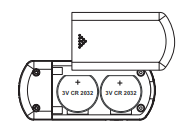
- Remove cover as shown . Insert battery with “+” side facing up. Slide the cover back on.
CAUTION: Batteries contain chemical substances, so they should be disposed of properly. Danger of explosion if battery is incorrectly replaced. Replace only with the same or equivalent type.
Power adapter (not included)
Only use AY3162 adapter (4.5V/450mA DC, positive pole to the center pin). Any other product may damage the player. 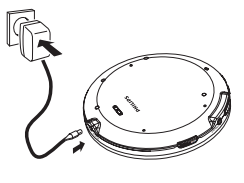
- Make sure local voltage corresponds to the power adapter's voltage.
- Connect the power adapter to the 4.5V DC jack of the player and to the outlet.
Helpful Hints:
– Always disconnect the adapter when you are not using it.
GENERAL INFORMATION
CD player and CD handling
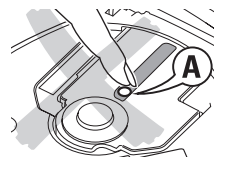
- Do not touch the lens A of the CD player.
- Do not expose the unit, batteries or CDs to humidity, rain, sand or excessive heat (caused by heating equipment or direct sunlight).
- You can clean the CD player with soft, slightly dampened, lint-free cloth. Do not use any cleaning agent as it may have a corrosive effect.
- To clean the CD, wipe it in a straight line from the center toward the edge using soft, lint-free cloth. The cleaning agent may damage the disc! Never write on a CD or attach a sticker to it.
- The lens may cloud over when the unit is moved suddenly from cold to warm surroundings. In that case, playing a CD is not possible. Leave the CD player in a warm environment until the moisture has evaporated.
- Active mobile phones in the vicinity of the CD player may cause malfunctions.
- Avoid dropping the unit as this may cause damage.
ENVIRONMENTAL INFORMATION
- All redundant packing material has been omitted. We have done our utmost to make the packaging easily separable into two mono materials: cardboard (box) and polyethylene (bags, protective foam sheet).
- Your set consists of materials which can be recycled if disassembled by a specialized company. Please observe the local regulations regarding the disposal of packing materials, dead batteries and old equipment.
COPYRIGHT INFORMATION
- The making of unauthorized copies of copy-protected material, including computer programmes, files, broadcasts and sound recordings, may be an infringement of copyrights and constitute a criminal offence. This equipment should not be used for such purposes.
- Windows Media and the Windows logo are trademarks, or registered trademarks of Microsoft Corporation in the United States and/or other countries.
HEADPHONE
HEADPHONE AY3806 (EXP256X series) and AY3806s (EXP258X series)
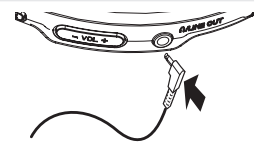
- Connect the supplied headphones to the
 / LINE OUT socket of the player.
/ LINE OUT socket of the player.
Helpful Hints:
 / LINE OUT can also be used to connect this set with your HiFi system. To adjust the sound and volume, use the controls on the connected audio equipment and the CD player.
/ LINE OUT can also be used to connect this set with your HiFi system. To adjust the sound and volume, use the controls on the connected audio equipment and the CD player.
Hearing Safety
Listen at a moderate volume:
- Using headphones at a high volume can impair your hearing. This product can produce sounds in decibel ranges that may cause hearing loss for a normal person, even for exposure less than a minute. The higher decibel ranges are offered for those that may have already experienced some hearing loss.
- Sound can be deceiving. Over time your hearing "comfort level" adapts to higher volumes of sound. So after prolonged listening, what sounds "normal" can actually be loud and harmful to your hearing. To guard against this, set your volume to a safe level before your hearing adapts and leave it there.
To establish a safe volume level:
- Set your volume control at a low setting.
- Slowly increase the sound until you can hear it comfortably and clearly, without distortion.
Listen for reasonable periods of time:
- Prolonged exposure to sound, even at normally "safe" levels, can also cause hearing loss.
- Be sure to use your equipment reasonably and take appropriate breaks.
Be sure to observe the following guidelines when using your headphones:
- Listen at reasonable volumes for reasonable periods of time.
- Be careful not to adjust the volume as your hearing adapts.
- Do not turn up the volume so high that you can't hear what's around you.
- You should use caution or temporarily discontinue use in potentially hazardous situations.
- Do not use headphones while operating a motorized vehicle, cycling, skateboarding, etc.; it may create a traffic hazard and is illegal in many areas.
ABOUT MP3 /WMA
The music compression technology MP3/WMA significantly reduce the digital data of an audio CD while maintaining CD quality sound.
- Getting MP3/WMA files: you can either download legal music files from the internet to your computer hard disc, or create such files by converting audio CD files in your computer through appropriate encoder software. (128kbps bit rate or higher is recommended for MP3 files and 64kbps bit rate or higher is recommended for WMA files)
- Creating a MP3/WMA CD: burn the music files from your computer hard disc on a CDR or CDRW using your CD burner.
Helpful Hints:
– Make sure that the file names of the MP3 and WMA files end with .mp3 and .wma.
– Total number of music files and albums: around 999 (with a typical file name length of 20 characters)
– The length of file names affects the number of tracks for playback. With shorter file names, more files can be burned on a disc.
The set complies with the FCC-Rules, Part 15 and with 21 CFR 1040.10. Operation is subject to the following two conditions:
- This device may not cause harmful interference, and
- This device must accept any interference received, including interference that may cause undesired operation.
QUICK START
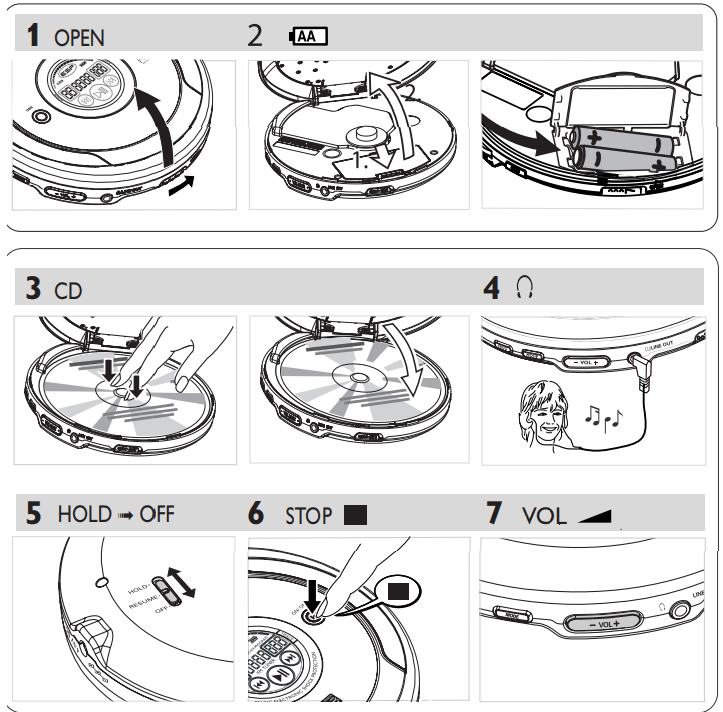

PLAYING A CD
This CD player can play all kinds of Audio Discs (including CD-Recordables and CD-Rewritables) and MP3/WMA CDs. Do not try to play a CD-ROM, CDi, VCD, DVD or computer CDs.
Important:
- CDs encoded with copyright protection technologies by some record companies may be unplayable by this product.
- For DRM protected WMA files, use Windows Media Player 10 (or later) for CD burning/conversion. Visit www. microsoft.com for details about Windows Media Player and WM DRM (Windows Media Digital Rights Management).
- Push the OPEN
 slider to open the player.
slider to open the player. 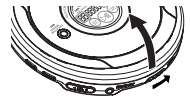
- Insert an audio CD or a MP3/WMA CD, printed side up, by pressing the CD onto the hub.
- Close the player by pressing the lid down.
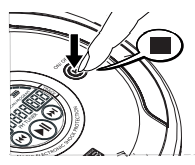
- Press
 to switch the player on and start playback.
to switch the player on and start playback.
➜ is displayed as the CD player scans the contents of a disc.
is displayed as the CD player scans the contents of a disc.
➜ Playback starts automatically.
Audio CD: the display shows current track number and elapsed playing time.
MP3/WMA CD: The display shows current album/track number and elapsed playing time.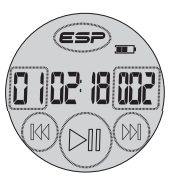
To pause playback 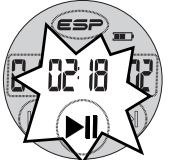
- Press
 ;.
;.
➜ The elapsed playing time and ; flashes.
; flashes. - Press
 ; again to continue playback.
; again to continue playback.
To stop playback
- Press
 .
.
➜ Audio CD: The display shows the total number of tracks and total playing time
MP3/WMA CD: The total numbers of tracks and albums are displayed respectively. - Press
 again to switch off the player.
again to switch off the player. - To remove the CD, hold it by its edge and press the hub gently while lifting the CD.

Helpful Hints:
– If there is no more activity, the set will automatically switch off after 25 seconds.
VOLUME AND SOUND
Volume adjustment
- Adjust the volume by using - VOL + (0-30).

Bass adjustment
Press DBB to switch the bass enhancement on or off
→DBB appears if the bass enhancement is activated.
SELECTING A TRACK AND SEARCHING
Selecting and searching on all discs
Selecting a track
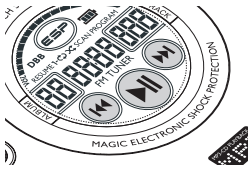
- Briefly press track digit on the screen, track digit
 and
and  will flash.
will flash. - Briefly press
 or
or  once or several times to skip to the beginning of the current, previous or subsequent track.
once or several times to skip to the beginning of the current, previous or subsequent track. - In the pause/stop position, press
 ; to start playback.
; to start playback.
➜Playback starts with the selected track.
Searching for a passage during playback
- Press and hold
 or
or  to find a particular passage in a backward or forward direction.
to find a particular passage in a backward or forward direction.
➜Searching starts while playback continues at low volume. After 2 seconds the search speeds up. - Release the button when you reach the desired passage.
➜Playback continues from this position.
Selecting on MP3/WMA CDs
To find a MP3/WMA track, you can first press “Album” then press  or
or  to select your desired album.
to select your desired album.
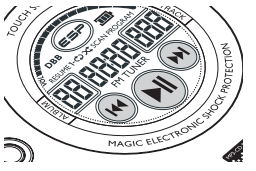
Selecting an album
- Briefly press album digit on the screen, album digit ∞ and § will flash
- Hold down or press
 or
or  repeatedly until you find the desired album number.
repeatedly until you find the desired album number. - In the pause/stop position, press
 ; to start playback.
; to start playback.
➜The first track of the selected album plays.
Helpful Hints: – During playback of a MP3/WMA CD track in program mode, use of “Album” is void.
SELECTING DIFFERENT PLAYING POSSIBILITIES − MODE
It is possible to play tracks in random order, to repeat a single track or the entire CD, and to play the first few seconds of each track.
- Press MODE once or more during playback to activate one of the following.
– : The current track plays repeatedly.
: The current track plays repeatedly.
– : All tracks of the disc/program play repeatedly.
: All tracks of the disc/program play repeatedly.
– : All tracks of the disc play repeatedly in random order
: All tracks of the disc play repeatedly in random order
– : All tracks of the disc play in random order once.
: All tracks of the disc play in random order once.
– SCAN: Each track in the disc plays 10 seconds in sequence.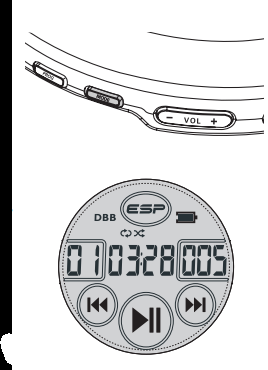
- To return to normal playback, press MODE repeatedly until the mode cursors disappear.

PROGRAMMING TRACKS
You can select up to 64 tracks and store them in the memory in a desired sequence. You can store any track more than once.
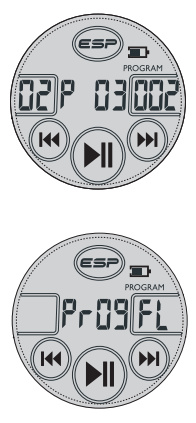
- Select a track with
 or
or  for a MP3/WMA CD.
for a MP3/WMA CD. - Press PROG to store the track.
➜ P with the number of stored tracks is displayed. - Select and store all desired tracks in this way.
- Press
 ; to start playback of your programmed tracks.
; to start playback of your programmed tracks.
➜ PROGRAM is shown and playback starts. - To add additional tracks to your program, press
 to stop playing the program and continue with steps 1 and 2.
to stop playing the program and continue with steps 1 and 2.
➜ After 64 tracks are stored, is shown.
is shown.
Reviewing the program
You can review the programme by pressing PROG for more than 3 seconds.
➜ All stored tracks are displayed in sequence.
Clearing the program
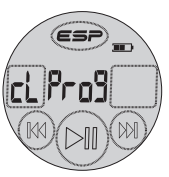
- If necessary, press
 to stop playback.
to stop playback. - Press 9 to clear the program.
➜ is displayed.
is displayed.
Helpful Hints:
– During programming, if no action is executed within 10 seconds, programming will stop automatically.
– The program will also be cleared if the power supply is interrupted, or if the player lid is opened, or if the set switches off automatically
RESUME / HOLD
RESUME (for audio CD only)- continuing from where you have stopped
You can store the last position played. When restarting, playback will continue from where you have stopped (RESUME). Use the HOLD. RESUME. OFF slider on the set for this function.
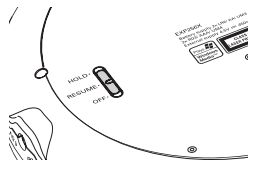
- Switch the slider to RESUME during playback to activate RESUME.
- Press
 whenever you want to stop playback.
whenever you want to stop playback. - Press
 ; whenever you want to resume playback
; whenever you want to resume playback
➜Playback continues from where you have stopped.
•To deactivate RESUME, switch the slider to OFF.
HOLD- locking all buttons
You can lock the buttons of the set. When a key is pressed, no action will be executed. With HOLD activated, you can avoid accidental activation of other functions.
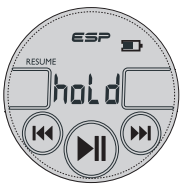
- Switch the HOLD. RESUME. OFF slider to HOLD to activate HOLD
➜ is displayed briefly.
is displayed briefly.
➜ All buttons are locked and no action will be executed when you press any button on the set. If the set is switched off, appears when
appears when  is pressed.
is pressed. - To deactivate HOLD, switch the slider to OFF
➜ All the buttons are unlocked.
ESP, POWER SAVE MODE
With a conventional portable CD player, you might have experienced that music stopped (e.g. when you were jogging). The Electronic Skip Protection prevents playback interruption caused by light vibrations and shocks. Continuous playback is ensured. However, ESP does not prevent playback interruptions during vigorous running. It also does not protect the unit against any damage caused by dropping!
The power save mode helps to extend battery service life for longer playback.
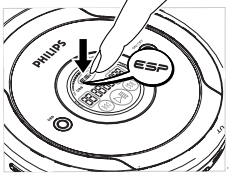
- Press once
 .
.
➜ appears when shock protection is activated
appears when shock protection is activated - To deactivate the shock protection and enter into the power save mode, press
 again.
again.
➜ icon will flash.
icon will flash.
➜ displays
displays
MAGIC ESP!
Average playing times when ESP skip protection activated :
Helpful Hints: – For a MP3/WMA CD,  is by default always activated.
is by default always activated.
TROUBLESHOOTING
WARNING: Under no circumstances should you try to repair the set yourself as this will invalidate the warranty. If a fault occurs, first check the points listed before taking the unit for repair. If you are unable to solve a problem by following these hints, consult your dealer or service center.
The CD player has no power, or playback does not start
- Check that your batteries are not empty, that they are inserted correctly, that the contact pins are clean.
- Your adapter connection may be loose. Connect it securely.
The indication  is displayed/CD cannot be read
is displayed/CD cannot be read
- Check that the CD is clean and correctly inserted (label-side upward).
- If your lens have steamed up, wait a few minutes until the lens clear up.
- CD-RW (CD-R) was not recorded properly. Use FINALIZE on your CD-recorder.
The indication  is on and/or there is no reaction to controls
is on and/or there is no reaction to controls
- If HOLD is activated, then deactivate it.
- Electrostatic discharge. Disconnect power or remove batteries for a few seconds.
Music files do not play
Check that the file names of MP3/WMA files end with .mp3. or .wma.
Some directories missing on MP3/WMA CDs
- Check that the total number of files and albums on your MP3/WMA CDs does not exceed 999 files and 99 albums.
- Only albums with MP3/WMA files are shown.
The CD skips tracks
- The CD is damaged or dirty. Replace or clean the CD.
- Shuffle or program is active. Switch off whichever is on.
Music skips or popping sounds when you play a MP3/WMA track
- Play the music file in your computer. If the problem remains, encode the audio track again and make a new CD.
No sound or bad sound quality
- Playback on pause. Press
 ;.
;. - Loose, wrong or dirty connections. Check and clean connections.
- Volume might not be appropriately adjusted. Adjust the volume.
- Strong magnetic fields. Check the player's position and connections. Also keep away from active mobile phones.
The indication  is displayed and the track cannot be played
is displayed and the track cannot be played
- The wma file is protected by WM DRM (Windows Media Digital Rights Management). Use Windows Media Player 10 (or later) for CD burning/conversion.
IMPORTANT SAFETY INSTRUCTIONS
- Read these instructions.
- Keep these instructions.
- Heed all warnings.
- Follow all instructions.
- Do not use this apparatus near water.
- Clean only with a dry cloth.
- Do not block any of the ventilation openings. Install in accordance with the manufacturers instructions.
- Do not install near any heat sources such as radiators, heat registers, stoves, or other apparatus (including amplifiers) that produce heat.
- Only use attachments/accessories specified by the manufacturer.
- Use only with a cart, stand, tripod, bracket, or table specified by the manufacturer or sold with the apparatus. When a cart is used, use caution when moving the cart/apparatus combination to avoid injury from tip-over.
- Refer all servicing to qualified service personnel. Servicing is required when the apparatus has been damaged in any way, such as if the power-supply cord or plug is damaged, liquid has been spilled or objects have fallen into the apparatus, or when the apparatus has been exposed to rain or moisture, does not operate normally, or has been dropped.
- Battery usage CAUTION – To prevent battery leakage which may result in bodily injury, property damage, or damage to the unit:
- Install ALL batteries correctly, + and - as marked on the unit.
- Do not mix batteries (OLD and NEW or CARBON and ALKALINE, etc.).
- Remove batteries when the unit is not used for a long time.
- Apparatus shall not be exposed to dripping or splashing.
- Do not place any sources of danger on the apparatus. (e.g. liquid filled objects, lighted candles).
- This product may contain lead and mercury. Disposal of these material may be regulated due to environment considerations. For disposal or recycling information, please contact your local authorities or the Electronic Industries Alliance : www.eiae.org.
See other models: PD700/37 24HFL2869T/12 DVDR3350H/37 26PW8402/37 HTS6500/37
